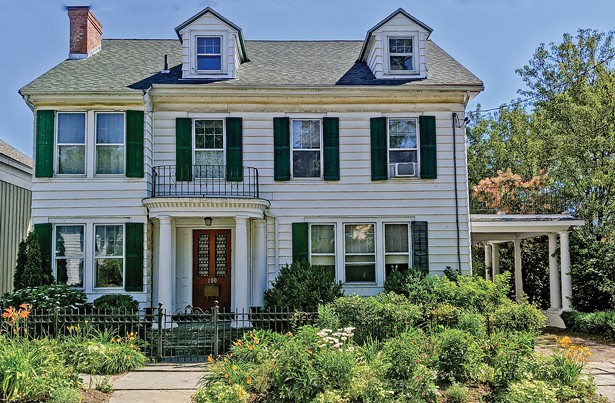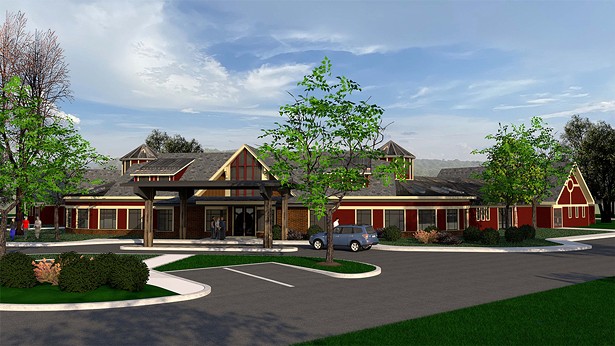For Elise Lark, the vision of establishing a good place to die is about our innate capacity to care for one another. "It's about changing the ways we think about, relate to, and care for those who are dying. It's about creating a good place to live."
This quote is found on a leaflet explaining Jim and Lisa's Circle Home, a soon-to-be ADA-compliant temporary residence. As the home's director, Lark is currently adapting the 3,500-square-foot Victorian house in Kingston's historic Rondout district, transforming the structure into a safe, comfortable home for those with only a short time to live.
The house is a project of the Kingston-based nonprofit Circle of Friends for the Dying (CFD), established in 2012. CFD will work together with hospice services to provide a home and support for those facing their final months. "When families are in the midst of this and they realize there are not a lot of resources, they start looking for information and a place," says Lark. "What people don't understand is that hospice is not a designated place, although some organizations have a designated hospice residence."
People receiving hospice care can be anywhere. "They can be at home, which is where the majority of our people are, or they can be in the hospital," says Lisa Wilson, executive director of Hudson Valley Hospice Foundation. "They can be in a nursing home, they can be living wherever they call home, but sometimes that doesn't fit perfectly or that just isn't feasible."
Some families don't have a safe home to spend their final months in. Some may not have a primary caregiver who can care for them around the clock as they decline. Nor can they afford to hire a caregiver. Jim and Lisa's Circle Home is a community-based effort that works to address this problem.
Family Values
The house was donated to CFD by Jim Gohlke, a member of an oncology support group that Lark ran, as a bequest after he died. Renovations began in January 2022 and Lark hopes to welcome the first guests next year. Lark can't be sure why Gohlke made such a generous donation, but she suspects that as a member of the oncology support group, he considered the end-of-life options and fears faced by his peers.
"Jim was part of those conversations," says Lark. "Jim saw how peers were talking about their distress and he also attended funerals. Prior to funerals we would go as small groups to visit people in their homes or in different care settings. The group became intimate in that sense."
Lark's sessions, which took place at a cancer support house, helped her realize how important it is to offer such services in a home care setting rather than a facility. To create a beautiful environment for residents' final months, she is carefully preserving the home's remarkable original features—ornate stone fireplaces, stained glass, intricate Victorian woodwork and a quiet garden. The home has a kitchen where families can prepare meals, a room where relatives from out of town can sleep over. The bedrooms offer views of the garden and the nearby park below.
"When people walk into the cancer support house they should feel at home," she says. "People understand home, you don't have to explain it. People get what that looks like and the feeling of comfort and security that comes with a home."
While CFD hired an architect and is working on renovations with a contractor, some renovation work is contributed by volunteers. Similarly, the future residence will have a small staff, including a nurse, as well as a rotating system of trained volunteers. "Our trained volunteers can do anything a family member in a private residence is expected to do," says Lark. "Our volunteers serve as extended family." The care model, called Comfort Care Homes for the Dying, began in Rochester in 1984. It now consists of about 30 homes statewide, acting independently but sharing information. The homes do share a common care culture, a basic philosophy, and operate in coordination with their local hospice agency.
"Hospice comes in and provides the medical oversight and then the home and the staff and the volunteers serve as an extended and surrogate family," says Lark. "It is not a replacement for family for those who have family, but we're extending that capacity of the family and we are a family for people who don't have a family. Comfort Care Homes for the Dying all share the philosophy of serving people with the greatest need and the fewest options at no cost to the residents."
According to Lark, Jim & Lisa's Circle Home will collaborate with Hudson Valley Hospice. "People will be enrolled in hospice either prior to or upon entry to the home, so we'll be getting referrals from hospice, from hospital discharge planners," says Lark. "Physicians can make referrals, family members can make referrals, and patients can even refer themselves. Anyone can make a referral."
Medicare and Medicaid and many private insurance plans cover hospice care, but some people are underinsured or uninsured. "We rely on private donations from individuals and local businesses," says Lark. "We're not funded by the government in terms of Medicaid or Medicare or by private insurance. This is a community endeavor. It really is the community that provides the financial support and in-kind donations. People also give their time."
Homelike Environment
In Hyde Park, the Poughkeepsie-based Hudson Valley Hospice Foundation is currently addressing the same issue on a slightly bigger scale. The foundation, which serves Ulster and Dutchess counties, began construction of Hospice House in December 2021 and hopes to complete the $10 million project by 2023. Hospice House will feature 14 self-contained private suites."They are furnished to create as much of a homelike environment as possible in each individual space," says Wilson. "We encourage people to bring things from home, photos and such, to make the room as much their own as possible for their time there. Two of those suites will be convertible to pediatric for the use of our littlest patients, when that's necessary. There is a full kitchen and dining room, a chapel, lounges, great room and reading nook, where people can find a quiet space or gather together. Every effort has been made to meet the needs of our patients and their loved ones."
Wherever patients call home, hospice can provide an interdisciplinary team that includes nurse case managers, home health aides, chaplains, music therapists, and other specialty therapists. Social workers are available to help patients and their families arrange whatever is needed—from planning a funeral to offering grief and bereavement services for 13 months after.
"It's a philosophy of care, of holistically treating the patient and supporting their loved ones," says Wilson.
Hudson Valley Hospice currently has more than 130 volunteers, including 44 specially trained end-of-life doulas. Similar to the way a birth doula assists in a birth, these doulas can help patients plan how they want to spend their final days. That can involve fostering a comfortable environment, serving as an advocate, or helping patients create a legacy in the form of something to pass on to loved ones, such as a scrapbook, a quilt, or a poem. Doulas can help with guided exercises to reduce anxiety.
Start The Conversation
One mistaken assumption about hospice care is that it's only available if you have less than six months to live, so enrollment should be delayed as long as possible. This misunderstanding results in families waiting too long to receive beneficial services, when, in fact, there is no rule determined by life expectancy. Jim and Lisa's Circle Home is set up to only accept patients with less than three months to live, but that's not true of hospice care in general, so it's important to find out what the options are."Nobody should have to die alone, in pain or without the support of hospice," says Wilson. "Everybody always says, 'We should have called sooner,' because a lot of people don't realize all of the pain and symptom management and support they can receive. We urge everyone to call. Ask the questions. Start the conversation."
Having the conversation can improve the quality of a patient's final days.
When Lark looks around her makeshift office, which will one day be the welcome center for Jim & Lisa's Circle Home, she notes how much sunshine the windows let in. "Some people might think this is morbid, but this home is not about death, it's about life and light."












